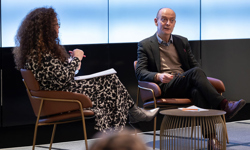
With the launch of its first website back in 1999 as a networking forum for internet professionals, one could be forgiven for thinking of Econsultancy as part of the digital establishment or old guard. Yet it is now Centaur Media’s largest business unit – accounting for 12% of the company’s revenue. And, under the leadership of recently appointed managing partner Ruth Mortimer, it is blazing a trail for digital transformation and redefining what a successful paid-content strategy can be.
Technically speaking, Econsultancy isn’t a publishing business.
Yes, the Econsultancy blog is a major draw to registered user and subscribers alike interested in all things related to digital marketing. And Econsultancy in its present form did evolve out of the £50m acquisition in 2012 by Centaur – publisher of Marketing Week and The Lawyer - of the what then billed itself as an ‘ecommerce and marketing innovation firm’.
But Mortimer, a former editor of Marketing Week, who moved to Econsultancy last October via Centaur’s Festival of Marketing which she’d managed since 2016, describes it as “a business that helps people solve problems in the media and marketing space”.
Many common themes unite Econsultancy with traditional content publishers, however.
Adding value
“Econsultancy is a business built on content for which people want to pay and to which people attribute value as it helps them do their job. It has a demonstrably value-driven way of looking at content, and I like that,” she says. “When people think of the publishing sector these days, they tend to think of it as being all about media and stories and that, as such, it’s about being interesting. But Econsultancy marries interesting with useful, and that’s what we need to be, a need-to-have not a might-like.”
Econsultancy is a global digital platform with offices in Singapore and New York (as well as London), creating and distributing information and insight from original research to 300,000 registered users and 15,000 paid subscribers. And its traffic is growing – in May 2018, it generated 600,000+ monthly uniques.
“Our blog on Econsultancy is an enormously important piece of marketing for us – it’s our shop window and what gets people excited about what we do. And it’s always rated by our paying customers as one of the most important things they pay for, even though it’s available to everybody,” Mortimer observes.
Econsultancy is also a trainer, with training offered through both its platform and live components – public training academies anyone can hook onto, which might be about best practice or search; round tables; networking and events for subscribers; and bespoke training for individual businesses.
Solving problems
But above all, Econsultancy is a problem-solver – deriving a growing proportion of its revenue through its own particular take on ‘paid-content’: a mix of information and insight through its digital platform and live events; original research; general and bespoke training; and tailored commercial packages that can straddle some or all as well as other Centaur Media products and brands – some developed with Centaur’s central cross-company commercial partnerships division Growth Partners, others by Econsultancy with its clients direct.
For one client, for example, Econsultancy recently created an event run by Mortimer combined with a sponsored session at the Festival of Marketing; a piece of sponsored research; and a partnership to get the Marketing Week Mini MBA (a CPD-accredited course for marketers to further develop their skills designed and taught to mirror the MBA core marketing courses offered by leading business schools) out to that company’s customers.
“I’m a passionate believer in commercial content being good. And we see content as being a lot broader than a piece of written content or an online video,” she says. “The ideal commercialised content deal for me involves someone paying for me to create a brilliant idea – which may just be for them, but could also be for the benefit of many other businesses. The key is to be entirely open with all customers about where the funding for an idea has come from, and that content generated has clear value.”
With a staff of 150 – 100 of whom are in the UK – Econsultancy’s workforce is split between content (for the blog, as well as editorial and sponsored research); capability (training developers and customer advisors expert in scoping clients’ needs); subscription & sales; and marketing. Every activity is closely interconnected, however.
“At Econsultancy, all constituent parts feed each other. The custom (bespoke) work we do with clients will inform research and reports, and we try to use the content and research we create in our training as nothing is more useful to any of what we do than understanding the real questions – and the real areas – our clients are struggling with,” Mortimer explains.
“We have registered users who enjoy the content and we hope they will become paying customers through their engagement with us. We have subscription customers – the larger part of our business - and we have training customers, who might come to us for a digital academy and leave with an Econsultancy subscription to keep them going. Our value lies in our mix and accounts people who can assess our customers’ needs to deliver a customer-first approach.”
Tailoring the content
One of Mortimer’s priorities since joining has been to strengthen the content and the capability teams.
“A big challenge is the great variety of customers we have,” Mortimer observes. “This is an enormous asset but, in terms of creating content, it is quite difficult. You have to remember that the chief marketing officers you serve who want to understand search, for example, require different content to recent graduates who’ve just joined a search engine optimisation team. Both are beginners in their own way but need an entirely different approach.”
Clearly, it’s much easier to have a smaller number of bigger customers to whom you can sell a greater number of things, she readily admits. However, you also have to think of the future of the business.
“One of the things that’s been really important at Econsultancy in the past is that a lot of today’s chief marketing and digital officers grew up with Econsultancy and as they moved from small companies to larger enterprises, took us with them. I want to make sure people starting out today will stay with us over the longer term, too, as they move on into larger businesses,” she adds.
Another priority has been product development and Mortimer is overseeing the launch of a new event – Econsultancy Live – and development of a new platform for Econsultancy’s digital offering which will add more practical tools to the information and knowledge mix when it goes live later this year.
“We have a very custom platform at the moment and the great thing about that is that it is custom to your needs, but the negative is that can be quite expensive to maintain and change and you need a lot of development work to do so,” she explains.
“Our CEO wanted me to match our ambitions as a business with our product and technology, and to bring it in line with technology used elsewhere in Centaur so that we could have the advantages of scale. At a company level, our ambition is to roll out the best solutions wherever they come from within the company company-wide. Our approach to product development is to ask: ‘does this have a bigger application than just what I do now?’”
To achieve this, a centralised digital development team at Centaur works with NPD people within each business portfolio – marketing, legal and financial – ensuring cross-fertilisation of ideas and collaboration cross-portfolio.
A further priority has been people, Mortimer adds.
“What I’ve also been doing here since joining is looking at our strategy and outlining that strategy for our staff. We’ve set up an internal group in charge of Econsultancy culture – and they are younger than me and thus more hip and interesting,” she says. “We want honest feedback because whatever transformation you want for your business, it will always start with people. We try really hard to make people feel they have a voice and a stake in what they do because you can’t just ask people to do a really good job – you have to show them how that happens and why it matters.”
Industry challenges
People – or, rather, failure to engage people with change – is one reason why some publishers’ attempts to digitally transform faltered, believes Mortimer, who has been closely involved in Centaur’s efforts to change the revenue mix of its business – away from print (which now accounts for just 10% of revenues), to paid content and events (digital premium content now accounts for 24%, and events 42%) – over the last four years.
A preoccupation with technology rather than its implications is another.
“At Amazon, the press release detailing the outcome is written at the start of any project – a brilliant way of centering your mind around what you want, and de-prioritising what’s less important,” she continues. “There is a danger in getting too insanely hung up on formats. It should just be about being a business where people want to find you, and I don’t mind how they find Econsultancy so long as they do.”
Looking ahead at how publishing is changing, Mortimer sees a number of lessons yet to be learned.
“Niche media is going to be important, but not have the same scale. We will see a publishing industry that’s increasingly dispersed which isn’t good or bad, just different,” she believes.
“B2C still has lessons to learn from B2B about how niche content adds true value when it’s hard to get that information in that depth from anyone else. Meanwhile, B2B can learn from B2C the importance of focus on customers and people – and that those people are not always driven by rational impulses.
“The lesson here is that B2C is great at telling stories and having emotional appeal and both are just as relevant in B2B.”
Another stumbling block for publishers – and businesses generally – struggling with change is the assumption that the transformation journey will ever be truly over, Mortimer points out. Which is why when it comes to future predictions for Econsultancy, she is sanguine: “Yes, there are business goals I want to meet. But as things now change so quickly, nothing is ever done and dusted. I can’t conceive where Econsultancy will be in five years’ time. But in some ways, I think, it’s much more exciting not to know.”












